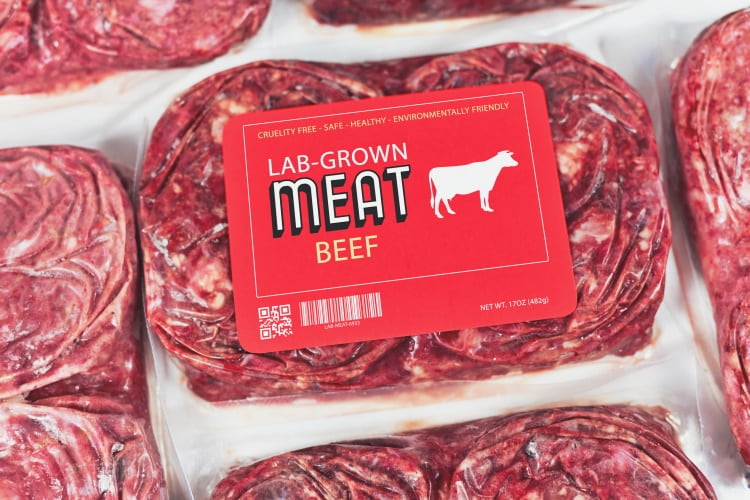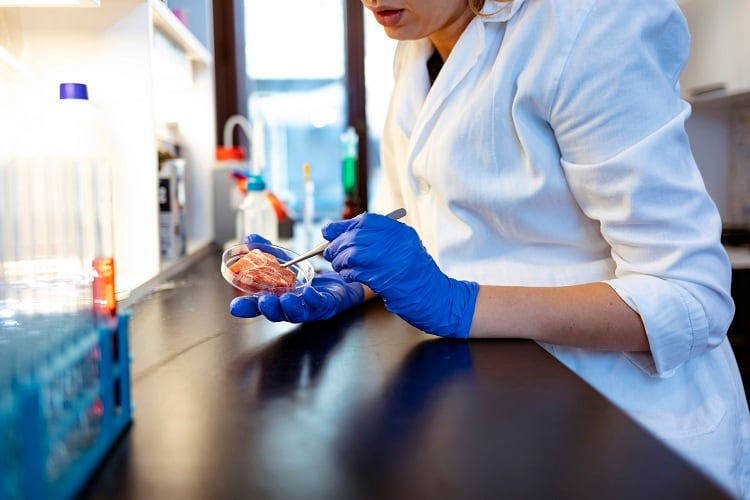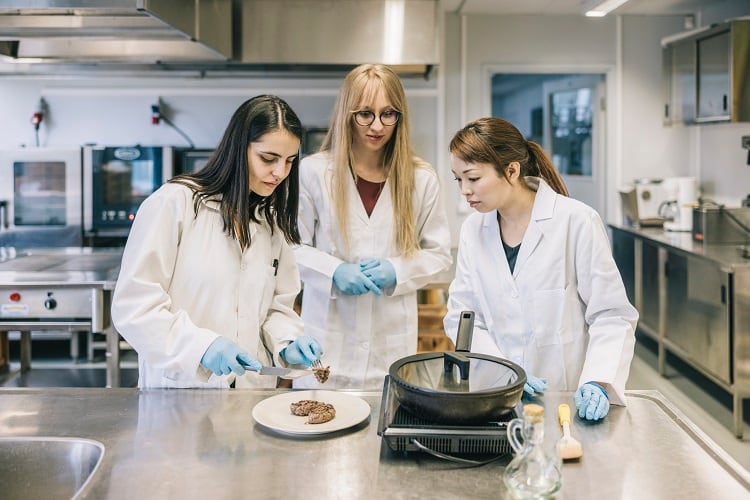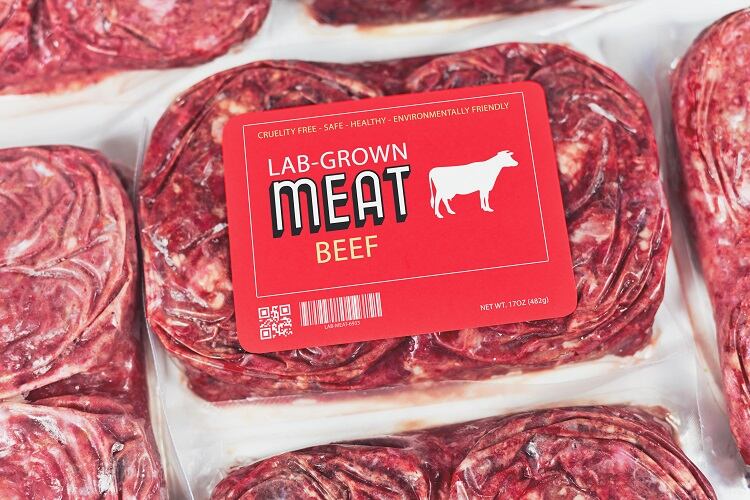Cultured meat might be biologically equivalent to traditional meat, but there are still many technical difficulties to solve to produce fresh meat-like artificial meat using cultured meat technology or bio-artificial meat using hydrogel scaffolds.
According to new research, published in journal Food Science of Animal Resources, this is of ‘utmost importance’ because consumer acceptance hinges on characteristics like colour, mouthfeel and – all importantly - taste. In particular, they suggest, scientific studies examining the taste profile of cultured meat are largely ‘insufficient’ because they were conducted in the ‘early period’ of cultured meat. In the paper, Seon-Tea Joo et al set out to fill this knowledge gap.
The study saw satellite cells extracted from chicken and cattle muscles cultured. The taste characteristics of the cultured meat tissue was then compared to those of traditional meat using an electronic tongue system.
So what were the results? Where there any noteworthy differences between cultured and traditional meats?
Different amino acid profiles influence taste
The amino acid composition of meat is important because it determines not only the nutritional quality but also taste, especially taste sensations. Amino acids are known to elicit complex tastes and the overall taste of amino acids was found to be a combination of basic tastes, such as sourness, sweetness, saltiness, bitterness, and umami.
“During the production of cultured meat with similar taste attributes, the amino acid composition of TM must be simulated. In particular, since the umami attribute of meat is important for good taste, simulating glutamic acid and aspartic acid, which are known to be closely correlated to umami is important,” the researchers contended.
The amino acid content of the muscle tissue was determined using a Biochrom30 plus amino acid analyser. Some significant differences between the amino acid composition of cultured and conventional meat were detected.
“The current findings in cattle showed that the glutamic acid content in CMT [cultured meat tissue] was within the normal range of that of TM [traditional meat] with no significant difference. However, since the aspartic acid content of CMT is lower than that of TM, it is considered necessary to find a method to increase the ratio of aspartic acid when culturing cattle satellite cells. In the case of chicken, the amount of aspartic acid and glutamic acid in CMT was significantly lower than that of TM, so when culturing chicken satellite cells, it is necessary to find a way to increase the proportions of glutamic acid and aspartic acid,” the researchers suggested.
They also noted that cultured meat could be sweeter than traditional meat due to their distinct amino acid profiles. “Meat sweetness is related to glycine, alanine, threonine, proline, and serine whereas bitterness is related to isoleucine, leucine, cysteine, lysine, tyrosine, phenylalanine, valine, arginine, methionine, and histidine. In this study, the significantly higher amounts of serine, proline, glycine, and alanine in CMT than in TM suggest that CMT may be sweeter than TM,” the paper noted.
Cultured meat could also be more bitter than traditional meat due to ‘significantly lower’ amounts of isoleucine, leucine, phenylalanine, histidine, and lysine.
“To produce cultured meat that is similar to TM, satellite cells should be cultured in a culture medium that can increase bitterness and reduce the sweetness. Unless special amino acids are added to the culture medium and taken up by the satellite cells, the amino acid composition of cultured meat will not be similar to that of TM, and eventually, the cultured meat will exhibit a different taste sensation compared to TM.”
Distinctions in nucleotide-related compound composition
Nucleotide-related compounds including adenosine-5'-monophosphate (AMP), inosine-5'-monophosphate (IMP), inosine, and hypoxanthine were determined using high-performance liquid chromatography.
“Among the nucleotide-related compounds, only a considerable of IMP was detected, whereas AMP, inosine, and hypoxanthine were measured in trace amounts,” the researchers concluded.
IMP contributes to several meat taste characteristics including umami and ‘brothy’ taste. The IMP content is released in the early stages of cooking and the amounts vary depending species and cut, due to differences in fibre composition.
“The present study showed that the IMP content of CMT was significantly lower than that of TM from both chicken and cattle. Therefore, it is expected that the umami intensity of CMT was weaker than that of TM due to the lower concentration of IMP,” the study revealed.
Comparing taste characteristics with an electronic tongue
The researchers used an electronic tongue system to determine the taste characteristics of the muscle tissue. The system was composed of five taste sensors and each sensor was attached to a typical artificial lipid membrane.
It looked at the umami, bitterness, sourness, astringency, richness, and saltiness of cultivated and traditional meat alternatives. Important differences were again detected.
“Both CMT and TM showed positive values for bitterness and richness, but negative values for sourness and saltiness. In addition, in both chicken and cattle CMTs, the umami values were positive, whereas that of TM was negative, and the astringency values showed the opposite tendency as the umami values. As a result, there were significant differences in umami, bitterness, sourness, and astringency,” the researchers concluded. “The umami, bitterness, and sourness values of CMT were significantly lower than those of TM from both chicken and cattle, whereas the astringency value was higher in CMT compared to TM.” No difference in saltiness was detected.
According to the scientists, the growth medium that cultured cells are grown in should be adjusted if cultivated meat innovators are to achieve taste parity with traditional meats.
“It is necessary to adjust the composition of the growth medium to a composition that could increase the umami intensity and the bitterness of CMT and develop a culture method of satellite cells that could produce cultured meat with a taste similar to that of traditional meat,” they concluded.
Source
‘A Comparative Study on the Taste Characteristics of Satellite Cell Cultured Meat Derived from Chicken and Cattle Muscles’
Food Science of Animal Resources
DOI: https://doi.org/10.5851/kosfa.2021.e72
Authors: Seon-Tea Joo, Jung-Suk Choi, Sun-Jin Hur, Gap-Don Kim, Chan-Jin Kim, Eun-Yeong Lee, Allah Bakhsh, Young-Hwa Hwang




